class 1 翻译的性质标准及要求
第一课翻译的性质和标准

➢ 严复对“信达雅”的关系的论述:“译事三难:信、 达、雅。求其信,已大难矣。顾信矣不达,虽译犹不 译也,则达尚焉。”“言之无文,行之不 远。”“信达而外,求其尔雅。”也就是说翻译应 求其信,但如不达,那等于没译,所以在信之外还 得求“达”,而所谓“尔雅”,就是要讲究“文采”, 以期“行远”(流传)。
• The Ball no question makes of Ayes and Noes,
• But Here or There as strikes the Player goes;
• And He that toss’d you down into the Field, • He knows about it all --- He knows --- He knows!
• 盖以人生受造,同得创造者之一定之理, 己不得弃,人不得夺,乃自然而然,以保 生命及自主、自立者也。(《自卫主治之 示》)
第12页,本讲稿共54页
• 《大美国史略》 (1899, Myron C. Wilcox 蔚利高、黄乃裳)
• 夫人皆受造而成,故同具有造之者之定理。 其理己不能弃,人不能夺,自然而然,用 以保其生命,而自主强立于天地之间。 (《美脱英轭为自主之布告》)
第23页,本讲稿共54页
• 皮球啊也只有惟命是从, • 一任那打球者到处抛弄; • 就是“他”把你抛到地来, • 一切的原由只有他懂 — 他懂
(郭沫若译)
第24页,本讲稿共54页
• 眼看乾坤一局棋, • 满秤黑白子离离。 • 铿然一子成何劫, • 惟有苍苍妙手知。
(黄克孙译)
第25页,本讲稿共54页
第29页,本讲稿共54页
Eugene Nida
➢Nida 对 翻 译 标 准 的 典 型 表 述 是 : To translate is to produce “the closest natural equivalent of the source language message.”
Unit one--翻译的性质,原则(陕西精品课程内部资料)
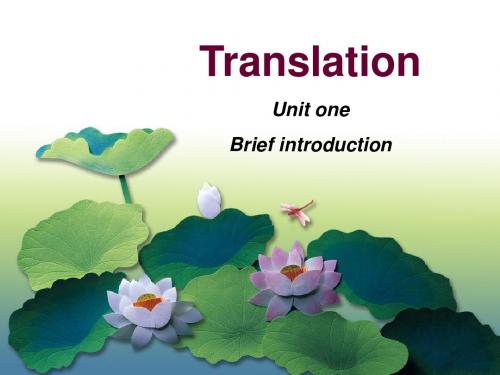
• TEM-8 Requirements: 能将中等难度的汉语篇章或 段落译成英语,速度和译文要求与英译汉相同。能力上 能担任外宾日常生活的口译。 能运用翻译的理论和技 巧,将英美报刊上的文章以及文学原著译成汉语,或将 我国报刊、杂志上的文章和一般文学作品译成英语,速 度为每小时250-300个英文单词。译文要求忠实原意, 语言流畅。
tion
*Concerning way of activity:
1.interpretation口译(consecutive interpretation即席翻译—部分或全部之后,再 译 & simultaneous interpretation同声传 译—边听边译);
2.translation笔译(虽不如口译时间限制紧迫, 但标准要求更高更严) 3.Machine translation 机器翻译
Classification
• *Concerning the type writing of the material: • Scientific materials科技文体、Translation of literary works文学文体、Translation of political essays政治文体、Translation of practical writing应用文体;etc. • * Concerning the way of disposal • full-text translation全译 • abridged translation节译 • adapted translation编译
• ---- Christiane Nord
Definition
*翻译是把一种语言文字的意义用另外一种 语言表达出来。 ----《现代汉语词典》
王治奎《大学英汉翻译教程》【笔记课后习题及翻译示例汇总】(翻译的性质、标准及要求)【圣才出品】
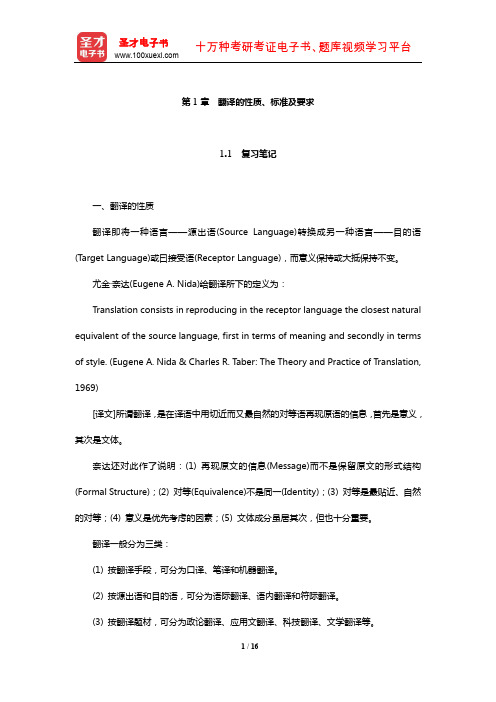
第1章翻译的性质、标准及要求1.1 复习笔记一、翻译的性质翻译即将一种语言——源出语(Source Language)转换成另一种语言——目的语(Target Language)或曰接受语(Receptor Language),而意义保持或大抵保持不变。
尤金·奈达(Eugene A. Nida)给翻译所下的定义为:Translation consists in reproducing in the receptor language the closest natural equivalent of the source language, first in terms of meaning and secondly in terms of style. (Eugene A. Nida & Charles R. Taber: The Theory and Practice of Translation, 1969)[译文]所谓翻译,是在译语中用切近而又最自然的对等语再现原语的信息,首先是意义,其次是文体。
奈达还对此作了说明:(1) 再现原文的信息(Message)而不是保留原文的形式结构(Formal Structure);(2) 对等(Equivalence)不是同一(Identity);(3) 对等是最贴近、自然的对等;(4) 意义是优先考虑的因素;(5) 文体成分虽居其次,但也十分重要。
翻译一般分为三类:(1) 按翻译手段,可分为口译、笔译和机器翻译。
(2) 按源出语和目的语,可分为语际翻译、语内翻译和符际翻译。
(3) 按翻译题材,可分为政论翻译、应用文翻译、科技翻译、文学翻译等。
二、翻译的标准翻译标准,亦曰翻译原则,即指导翻译实践、评价译文质量的尺度。
(一) 泰特勒的三原则与严复的三字标准1. 亚历山大·F·泰特勒(Alexander Fraser Tytler)在《论翻译的原则》中提出了三条基本原则:(1) A translation should give a complete transcript of the ideas of the original work.(译文应完全复写出原作的思想。
class-1-翻译的性质标准及要求

sophisticated
• • • • Sophisticated man • Sophisticated woman • Sophisticated columnist • Sophisticated electronic • device • Sophisticated weapon • 老于世故的人 狡黠的女人 老练的专栏作家 高度精密的电子仪器 尖端武器
• 6. China’s entry in to WTO and the awarding of the 2008 Summer Olympics to Beijing have caused many developers to push their way into the city’s property market. • 7. The price of vegetables has rocketed recently. • 8. He allowed his abilities to run to seed. • 9. In order to overcome transport difficulties, it is suggested that firms should stagger working hours. • 10. I’ve no objection to your having an hour off to go shopping if you can get anyone to stand in for you. • 11. If a person had once been taken to her heart, she would hear nothing said against him.
Reflections
翻译的标准是什么
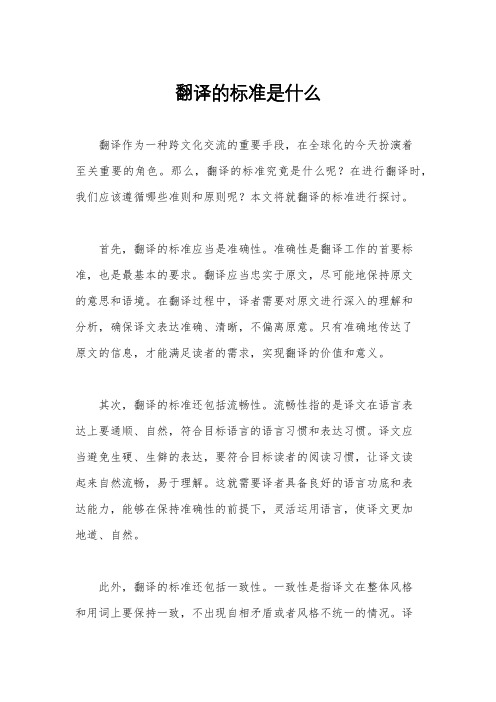
翻译的标准是什么翻译作为一种跨文化交流的重要手段,在全球化的今天扮演着至关重要的角色。
那么,翻译的标准究竟是什么呢?在进行翻译时,我们应该遵循哪些准则和原则呢?本文将就翻译的标准进行探讨。
首先,翻译的标准应当是准确性。
准确性是翻译工作的首要标准,也是最基本的要求。
翻译应当忠实于原文,尽可能地保持原文的意思和语境。
在翻译过程中,译者需要对原文进行深入的理解和分析,确保译文表达准确、清晰,不偏离原意。
只有准确地传达了原文的信息,才能满足读者的需求,实现翻译的价值和意义。
其次,翻译的标准还包括流畅性。
流畅性指的是译文在语言表达上要通顺、自然,符合目标语言的语言习惯和表达习惯。
译文应当避免生硬、生僻的表达,要符合目标读者的阅读习惯,让译文读起来自然流畅,易于理解。
这就需要译者具备良好的语言功底和表达能力,能够在保持准确性的前提下,灵活运用语言,使译文更加地道、自然。
此外,翻译的标准还包括一致性。
一致性是指译文在整体风格和用词上要保持一致,不出现自相矛盾或者风格不统一的情况。
译者需要在整个翻译过程中保持一贯的风格和用词,不因为个别词语或句子而脱离整体。
这就需要译者在翻译过程中保持高度的专注和耐心,不断地反复斟酌,确保译文的一致性和连贯性。
最后,翻译的标准还包括传达原文的风格和情感。
翻译不仅仅是对文字的转换,更是对文化、情感和思想的传递。
译者需要在翻译过程中理解原文所表达的情感和风格,尽可能地将其传达到译文中去。
这就需要译者具备敏锐的感知能力和良好的文学素养,能够捕捉到原文中的情感和风格,用目标语言恰当地表达出来。
总之,翻译的标准是多方面的,涉及到准确性、流畅性、一致性以及情感传达等多个方面。
在进行翻译时,译者需要全面考量这些标准,不断地提高自身的语言能力和翻译水平,以求更好地满足读者的需求,实现翻译的价值和意义。
英汉翻译讲义
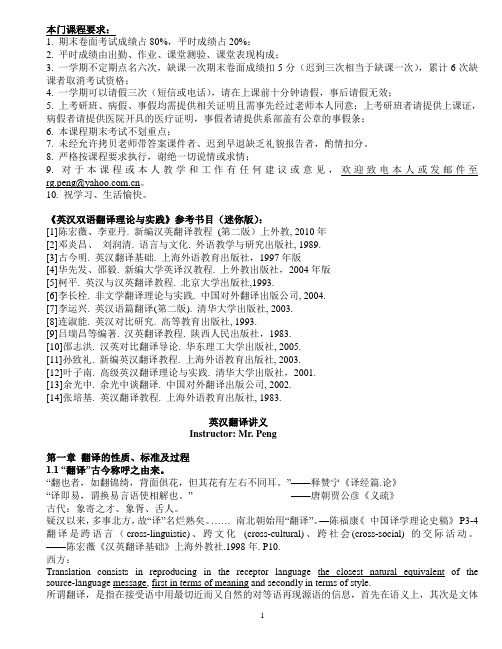
本门课程要求:1. 期末卷面考试成绩占80%,平时成绩占20%;2. 平时成绩由出勤、作业、课堂测验、课堂表现构成;3. 一学期不定期点名六次,缺课一次期末卷面成绩扣5分(迟到三次相当于缺课一次),累计6次缺课者取消考试资格;4. 一学期可以请假三次(短信或电话),请在上课前十分钟请假,事后请假无效;5. 上考研班、病假、事假均需提供相关证明且需事先经过老师本人同意;上考研班者请提供上课证,病假者请提供医院开具的医疗证明,事假者请提供系部盖有公章的事假条;6. 本课程期末考试不划重点;7. 未经允许拷贝老师带答案课件者、迟到早退缺乏礼貌报告者,酌情扣分。
8. 严格按课程要求执行,谢绝一切说情或求情;9. 对于本课程或本人教学和工作有任何建议或意见,欢迎致电本人或发邮件至rg.peng@。
10. 祝学习、生活愉快。
《英汉双语翻译理论与实践》参考书目(迷你版):[1]陈宏薇、李亚丹. 新编汉英翻译教程(第二版)上外教, 2010年[2]邓炎昌、刘润清. 语言与文化. 外语教学与研究出版社, 1989.[3]古今明. 英汉翻译基础. 上海外语教育出版社,1997年版[4]华先发、邵毅. 新编大学英译汉教程. 上外教出版社,2004年版[5]柯平. 英汉与汉英翻译教程. 北京大学出版社,1993.[6]李长栓. 非文学翻译理论与实践. 中国对外翻译出版公司, 2004.[7]李运兴. 英汉语篇翻译(第二版). 清华大学出版社, 2003.[8]连淑能. 英汉对比研究. 高等教育出版社, 1993.[9]吕瑞昌等编著. 汉英翻译教程. 陕西人民出版社,1983.[10]邵志洪. 汉英对比翻译导论. 华东理工大学出版社, 2005.[11]孙致礼. 新编英汉翻译教程. 上海外语教育出版社, 2003.[12]叶子南. 高级英汉翻译理论与实践. 清华大学出版社,2001.[13]余光中. 余光中谈翻译. 中国对外翻译出版公司, 2002.[14]张培基. 英汉翻译教程. 上海外语教育出版社, 1983.英汉翻译讲义Instructor: Mr. Peng第一章翻译的性质、标准及过程1.1 “翻译”古今称呼之由来。
第三章 翻译的原则
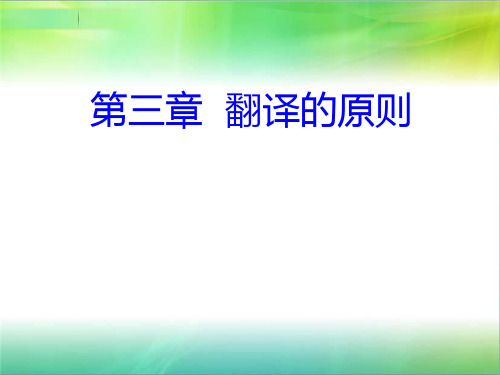
• 诗歌翻译家许渊冲:“意美、音美、形美” ( beautiful in sense, in sound and in form) • 翻译理论家刘宓庆 刘宓庆:“三性”标准:真实性、清晰 刘宓庆 性、约定性。
–真实性:译文与原文对等, –清晰性:译文思路清晰,陈词明晰, –约定性:译语符合约定俗成的原则,避免任意性。
第三章 翻译的原则
第一节
翻译标准的厘定
• 1、传统的西方翻译标准 、
• 古罗马翻译家兼演说家西塞罗(Marcys Tullius Cicero) :“翻译不应拘泥于原文的词语而应注重原文的思想”,“不 可逐字死译而要符合译文的语言规则和特性”,主张翻译“不 是字当句对,而是保留语言总的风格和力量”。 ” • 古罗马诗人贺拉斯(Quintus Horatius):“忠实原著的译 者不会逐字直译”。 • 修辞学家昆提利安:既要注重译文语言规律,又要传达原 文特色。 • 神学家奥古斯汀(St. Augustine):“宁要内容精准,不要 风格优雅”。
• 三种单纯而极其强烈的激情主宰了我的一生:对 爱情的渴望、对知识的探索和对人类苦难的难以 忍受的怜悯。这三种激情,犹如强劲的狂风,卷 着我忽东忽西,飘浮不定,把我吹抵深深的苦海 ,几近绝望的边缘。
二、通 顺
• “通顺”指译文必须符合译入语的语言规范,文从 通顺”指译文必须符合译入语的语言规范, 通顺 句顺,明白流畅, 句顺,明白流畅,让读者阅读译文时就像阅读用 母语写出的文章。 母语写出的文章。 • 1、如何避免英译汉过程中的 翻译腔 翻译腔” 、如何避免英译汉过程中的“翻译腔
• 张今 张今:“真、善、美”
–“真”:翻译的真实性, –“善”:翻译的思想性, –“美”:翻译的艺术性。
பைடு நூலகம்
翻译的标准是什么
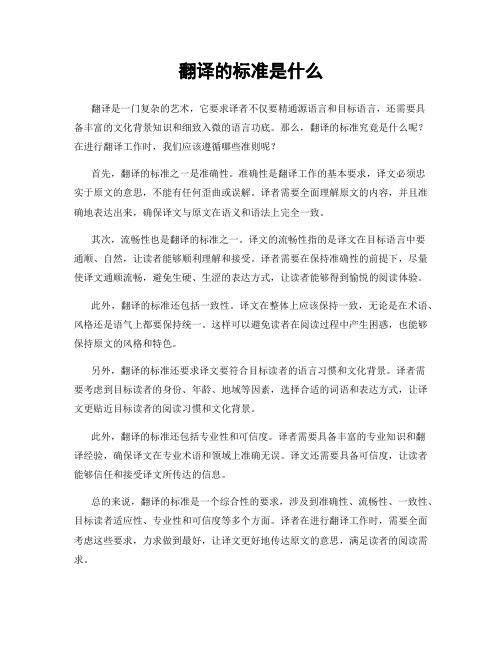
翻译的标准是什么翻译是一门复杂的艺术,它要求译者不仅要精通源语言和目标语言,还需要具备丰富的文化背景知识和细致入微的语言功底。
那么,翻译的标准究竟是什么呢?在进行翻译工作时,我们应该遵循哪些准则呢?首先,翻译的标准之一是准确性。
准确性是翻译工作的基本要求,译文必须忠实于原文的意思,不能有任何歪曲或误解。
译者需要全面理解原文的内容,并且准确地表达出来,确保译文与原文在语义和语法上完全一致。
其次,流畅性也是翻译的标准之一。
译文的流畅性指的是译文在目标语言中要通顺、自然,让读者能够顺利理解和接受。
译者需要在保持准确性的前提下,尽量使译文通顺流畅,避免生硬、生涩的表达方式,让读者能够得到愉悦的阅读体验。
此外,翻译的标准还包括一致性。
译文在整体上应该保持一致,无论是在术语、风格还是语气上都要保持统一。
这样可以避免读者在阅读过程中产生困惑,也能够保持原文的风格和特色。
另外,翻译的标准还要求译文要符合目标读者的语言习惯和文化背景。
译者需要考虑到目标读者的身份、年龄、地域等因素,选择合适的词语和表达方式,让译文更贴近目标读者的阅读习惯和文化背景。
此外,翻译的标准还包括专业性和可信度。
译者需要具备丰富的专业知识和翻译经验,确保译文在专业术语和领域上准确无误。
译文还需要具备可信度,让读者能够信任和接受译文所传达的信息。
总的来说,翻译的标准是一个综合性的要求,涉及到准确性、流畅性、一致性、目标读者适应性、专业性和可信度等多个方面。
译者在进行翻译工作时,需要全面考虑这些要求,力求做到最好,让译文更好地传达原文的意思,满足读者的阅读需求。
英语翻译翻译第1课优质公开课获奖课件
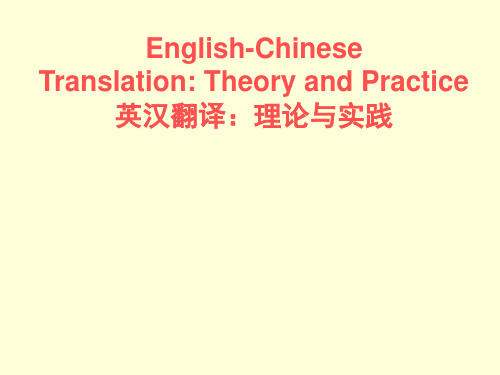
一词多义与上下文
• [4] 传说、说法等 • He’ll be very happy if that story holds up.
• [5] 热门、有意的渲染、谎言等 • The story about him became smaller and
by and by faded out from the American television.
•
会高超翻译技巧
•
持严肃认真态度
•
具一丝不苟精神
•
应勤查勤用词典
•
培养多种思维力
•
不断总结与完善
课堂教学活动环节
I. 常用翻译技巧与方法(约40分钟) II. 基本理论(约30分钟) III.III.实践讨论 (20分钟)
本学期教学内容安排
常用翻译技巧/方法安排
• 第十五周:状语从句的译法 • 第十六周:词序调整法 • 第十七周:语态变换译法 • 第十八周:长句译法 • 第十九周:释义(意)法
• 定义9:“翻译是一种需要艺术创造性形象思维的 语际转换操作活动” ,“翻译是一种需要运用相 应科学(即有关学科理论)知识的语际转换操作 活动”。(曾利沙)
翻译的特点之一
• 语言、文化、思维差异往往造成不同民族 语言使用者所用的语言具有不可对应的表o be no more to lay down one’s life to die martyr to expire to pass away to end one’s day to breath one’s last to go west to come to a violent death to give up to the ghost
• 定义3:“翻译就是用接受语复制出原语信 息最接近的自然本质体——首先就意义而言, 其次就其风格而言。”(Nida)
英汉翻译教程 全套课件

13
第一章:翻译概述——翻译的定义
Alexander Fraser Tytler:
A good translation is one which the merit of the original work is so completely transfused into another language as to be as distinctly apprehended and as strongly felt by a native of the country to which that language belongs as it is by those who speak the language of the original work.
3.《英汉翻译概要》,靳梅林 编著, 南开大学出版 社,1998年。
4.《新编汉英翻译教程》,陈宏薇 编著,上海外语教 育出版社,2004年。
5.《英汉翻译教程》,连淑能 编著,高等教育出版社, 2006年。
8
导学——学习网站
1. 中国翻译协会 /tran/index.htm 2. 中国科技翻译
4
导学——课程要求
Classroom polices: Late work: Assignments must be turned in on the due date for
full credit. Unless otherwise indicated, all assignments will be due at the beginning of the class period. Assignments that are turned in late will lose 5% per day. Copying and Plagiarism:
机构名称英译规范

上海市对外交流用组织机构名称和职务职称英文译写规范0 总则0.1 为规范本市组织机构名称和职务职称英文译写,促进对外交流,根据《中华人民共和国国家通用语言文字法》《上海市实施〈中华人民共和国国家通用语言文字法〉办法》《公共场所英文译写规范》 (DB31/T 457-2022) 《上海市人民政府关于加强本市公共场所英文译名使用管理的若干意见》,及国家和本市其他有关规定,制定本规范。
0.2 本规范合用于本市各级党政机关、群众团体和相关组织机构名称,各类职务职称的英文译写。
0.3 各级党政机关的招牌、指示牌应当按照国家有关规定,使用国家通用语言文字。
本规范提供的机关和组织机构名称英语译文用于对外交流。
0.4 使用汉语拼音拼写,应符合GB/T 16159 的规定。
1 组织机构名称的英译方法和要求1.1 译写组织机构名称,应当符合《中华人民共和国国家通用语言文字法》,在首先使用国家通用语言文字的前提下进行译写。
1.2 译写组织机构名称,应针对其不同的构成成份,采用相应的英译方法。
组织机构名称的构成成份,普通分析为冠名、属性名、序列名和通名。
1.3 冠名1.3.1 冠名中的地名冠名中涉及中国地名的普通用汉语拼音拼写。
如:上海 (市) Shanghai;黄浦 (区) Huangpu。
1.3.2 冠名中的行政区划限定词冠名中含有“市、区、新区、县、乡、镇”等行政区划限定词的,需区分不同情况作出处理。
——以下情形应当译出行政区划限定词与同级人民政府有隶属关系的部门、机构,应当译出同级的行政区划限定词,如:上海市农业委员会Shanghai Municipal Agriculture Commission ,嘉定区财政局Jiading District Finance Bureau。
需要译出行政区划限定词的,市译作Municipal,区译作District,新区译作New Area,县译作County,乡、镇均译作Township。
英汉翻译第1章(我国历史上的翻译活动)
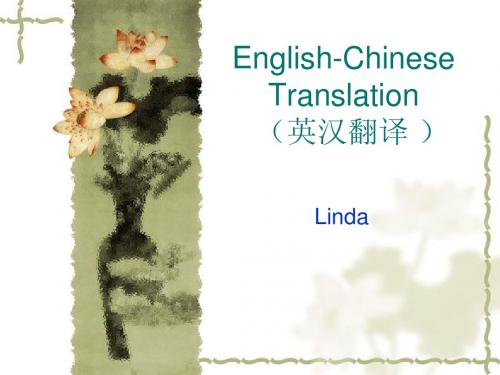
第一节 从周代到东汉桓帝的翻译活动
一、 《礼记·王制》载有周代所设翻译东、西、南、 北各地区少数民族语言的官员的职称: 五方之民,言语不通,嗜欲不同。达其志, 通其欲,东方曰寄,南方曰象,西方曰狄, 北方曰译。 故后世称翻译人员为“ ”。
《 》中谈到周代规定每七年要将各诸侯国的 翻译人员集中到周天子所在地加以训练。这 也是我国典籍中关于培训翻译人员的最早记 载。 在《 》古书中,也有周王朝当时的翻译官 的专门职称的记载。
这一时期代表人物有: 郑振锋,郁达夫,巴金,林语堂,傅雷,朱 光潜等
林语堂(1895.10.3-1976.3.26)福 林语堂
建龙溪人。原名和乐,后改玉堂,又改语堂。
《论翻译》1933年 “第一是忠实标准,第 二是通顺标准,第三是 美的标准” “翻译是一种艺术” 译文应有五美:
鲁迅(1881—1936) (1881 1936 1936) 原名周树人,字豫才,浙江绍兴人
二、课程要求 要求学生至少熟读教材课本,同时通读同类 教材一本,和外国名著中英版。且对三本书 就某一点或某一方面至少写读后感三篇,每 篇字数不少于一千。读后感只能手写。其他 考试要求照旧。 教材:庄传译,英汉翻译简明教程,外语教 学与研究出版社
学习指导:
该课程是一门实践性很强的课程。除了学习和 掌握翻译的基本原理以外,翻译实践占有相当 大的比重。具体地说,翻译练习由两部分组成, 一部分是课后的英译汉练习,另一部分是老师 课外挑选的翻译材料。 翻译是一项艰苦的脑力劳动,学好翻译需要付 出艰苦的努力,绝无捷径可走。对照阅读是一 种一举多得的学习方法。
《英汉双解英语谚语词典》盛绍裘,李永芳主编,知识出 版社,1989年版 《朗文当代高级英语词典》(英英,英汉双解)商务印书 馆,朗文出版社,1998年版 《英语缩略词词典》史群编,商务印书馆,1979年版 《简明美国俚语词典》杨志达编译,商务印书馆,1986 年版 《简明英汉世界文学词典》杜友良主编,中国对外翻译出 版公司,1992年版
翻译的性质标准及要求

翻译的种类
根据不同的标准,翻译可以分为 多种类型,如语内翻译、语际翻 译、符号翻译等。
翻译的特性
准确性
翻译的首要特性是准确性,译文必须忠实于原文,准确地传达原文的内容和意义。
流畅性
流畅性是翻译的重要特性之一,译文应该通顺、自然,易于理解,符合目标语言的表达 习惯。
文化性
翻译不仅是语言之间的转换,更是文化之间的传递。译文应该尽可能保留原文的文化特 色和内涵,以实现跨文化的交流和理解。
语言习惯的转换
总结词
保持译文语言的自然流畅
详细描述
在翻译过程中,译者需要关注原文和译文的语言习惯,以确保译文语言的自然流畅。这包括对原文的 句式、语气、修辞等方面的处理,以及在译文中运用符合目标语言习惯的表达方式。
专业术语的运用
总结词
准确翻译专业术语
VS
详细描述
在翻译涉及特定领域的文本时,专业术语 的准确翻译至关重要。为了确保译文的准 确性,译者需要具备相关领域的知识储备 ,并能够根据上下文选择合适的术语进行 翻译。同时,对于不确定的术语,译者需 要进行查证和核实,以确保译文的准确性 。
翻译的种类
口译
口译是指通过口头表达将一种语 言的信息用另一种语言表达出来,
通常用于会议、谈判、演讲等场 合。
笔译
笔译是指通过书面文字将一种语言 的信息用另一种语言表达出来,如 文学翻译、科技翻译、商务翻译等。
同声传译
同声传译是指在讲话人讲话的同时, 将讲话内容用另一种语言表达出来, 通常用于国际会议、商务谈判等场 合。
翻译的速度与效率
翻译速度的要求
在保证翻译质量和准确性的前提 下,需要尽可能提高翻译的速度 ,以满足客户的需求。
翻译效率的提高
北京市组织机构职务职称英文译法通则

北京市组织机构职务职称英⽂译法通则组织机构、职务职称英⽂译法通则1范围本标准规定了组织机构、职务职称英⽂译法的通⽤原则。
本标准适⽤于组织机构名称、组织机构地址及职务职称的英⽂译法。
2规范性引⽤⽂件下列⽂件中的条款通过本标准的引⽤⽽成为本部分的条款。
凡是注⽇期的引⽤⽂件,其随后所有的修改单(不包括勘误的内容)或修订版均不适⽤于本标准,然⽽,⿎励根据本标准达成协议的各⽅研究是否可使⽤这些⽂件的最新版本。
凡是不注⽇期的引⽤⽂件,其最新版本适⽤于本标准。
GB/T 16159 汉语拼⾳正词法基本规则DB11/T 334 公共场所双语标识英⽂译法通则DB11/T 334.1 公共场所双语标识英⽂译法道路交通3基本要求3.1英⽂单词应采⽤美式拼法。
3.2组织机构名称中实意单词⾸字母⼤写,连字符“-”后⾸字母⼤写,例如:Sub-District。
3.3职务职称作为专有名词时,实意单词⾸字母⼤写,连字符“-”后⾸字母⼤写。
3.4汉语拼⾳⽤法应符合GB/T 16159的要求。
4组织机构译法4.1通⽤名词译法4.1.1委员会委员会可译为commission或者committee。
相对独⽴、承担有⼀定普适性管理职能的委员会⼀般译为commission,例如:北京市教育委员会,译为Beijing Municipal Commission of Education。
在某⼀⾏政区域之内、某⼀机构之下的专设部门或派出机构⼀般译为committee,例如:中关村科技园区管理委员会,译为Management Committee of Zhongguancun Science and Technology Park。
4.1.2局局译为bureau。
市级局和区(县)级局均译为bureau,级别属性由上下⽂表述,例如:北京市商务局,译为Beijing Municipal Bureau of Commerce。
北京市东城区商务局,译为Dongcheng District Bureau of Commerce of Beijing Municipality。
翻译class

翻译class基本解释●class:班级,类别,等级●/klæs/●n. 班级,类别,等级●v. 分类,归类变化形式●n. 复数形式:classes●v. 第三人称单数:classes●过去式:classed●过去分词:classed●现在分词:classing具体用法●●n.:o班级,类别,等级o同义词:category, group, type, division, ranko反义词:disorder, disorganization, chaos, confusion, messo例句:●The teacher asked the class to submit their assignments byFriday. (老师要求班级在星期五之前提交作业。
)●She belongs to the upper class of society, which often attendsexclusive events. (她属于社会的上层阶级,经常参加专属活动。
)●The biology class was particularly interesting because of thehands-on experiments. (生物课特别有趣,因为有动手实验。
)●In the animal kingdom, mammals are a class of warm-blooded vertebrates. (在动物王国中,哺乳动物是温血脊椎动物的一类。
)●The class of 2023 is preparing for their graduation ceremonynext month. (2023届的班级正在为下个月的毕业典礼做准备。
)●The new smartphone model is in a class of its own with itsadvanced features. (这款新智能手机以其先进的功能独树一帜。
- 1、下载文档前请自行甄别文档内容的完整性,平台不提供额外的编辑、内容补充、找答案等附加服务。
- 2、"仅部分预览"的文档,不可在线预览部分如存在完整性等问题,可反馈申请退款(可完整预览的文档不适用该条件!)。
- 3、如文档侵犯您的权益,请联系客服反馈,我们会尽快为您处理(人工客服工作时间:9:00-18:30)。
Reflections
• 兼顾忠实与通顺 • 忠实:保持原作意义以及风格,即:原作 的民族风格、时代风格、语体风格、作者 个人风格。 • 通顺:即指译文语言必须通顺易懂,符合 规范。
翻译的过程
理解 表达 审校
Surface meaning Deep meaning context
1.语言能力英语/ 汉语 2.翻译技巧 3.防止两种倾向 过分表达 欠表达
• Eugene A. Nida Translating consists in reproducing in the receptor language the closest natural② equivalence ③ of the source-language message ①, first in terms of meaning④ and secondly in terms of style⑤. • [1]再现原文的信息(message),而不是保持原 文的形式结构 • [2]closet, natural • [3] equivalence 对等;对等≠同一 • [4] meaning first • [5] style is also important
• These developing countries cover vast territories, encompass a large population, and abound in natural resources. • 这些发展中国家,土地辽阔,人口众多, 资源丰富。 • The level of education of women still falls short of the proclaimed goals. • 妇女受教育的水平尚未达到宣布的目标。
sophisticated
• • • • Sophisticated man • Sophisticated woman • Sophisticated columnist • Sophisticated electronic • device • Sophisticated weapon • 老于世故的人 狡黠的女人 老练的专栏作家 高度精密的电子仪器 尖端武器
正译与反译
提高翻译能力的方法
• • • • • • • 翻译理论+翻译技巧+翻译实践 翻译实践: 1.词语——句子——段落——语篇 2.选择不同体裁和题材的练习材料 3.难易循序渐进 4.反复修改译文 5.选择有参考译文的文本,进行对比学习
参考书目
• 冯庆华,《实用翻译教程》(英 汉互译增订本),上海:上海外 语教育出版社,2002 • 古今明,《英汉翻译基础》,上 海:上海外语教育出版社 1997 • 孙致礼,《新编英汉翻译教程》, 上海:上海外语教育出版社, 2003
何谓翻译症
• 翻译腔/翻译体 • 把原语的语言形式、表达方式、句法结构机械 的移植到译入语中,因而形成一种不符合译入 语表达习惯的语言混合体。其主要特征是只顾 在形式上逐词逐句地紧随原文,忽略译入语语 言结构的特点和习惯表达方式,译文生硬牵强, 可读性差。
翻译症的原因
• 1.理解错误 • 2.表达错误
Reflections
• 1. 翻译是一种语言活动过程,同时又是该 活动的结果。 • 2.翻译过程不仅涉及两种语言,而且还涉及 两种社会文化。 • 3.翻译是一项创造性地实践活动。 • 4.交叉学科。 • 5.翻译是一门艺术。
• • • • • • • • • • •
按语言分类: Intralingual translation 语内翻译 Interlingual translation 语际翻译 按活动形式分类: Translation Oral interpretation Machine translation 按翻译材料的文体分类: 应用文体、科技文体、论述文体、新闻问题、政论等 按处理方式: 全译、节译、摘译、编译、述译
翻译的分类
翻译的标准
• 西方翻译理论 • 中国传统翻译理论
西方翻译理论
• Alexander F. Tytler • That the translation should give a complete transcript of the ideas of the original work. • That the style and manner of writing should be of the same character with that of the original. • That the translation should have all the ease of original composition.
Exercise 1
• 1. Half the prize money he spent, and the rest was laid aside for a rainy day. • 2. The opposition speaker accused the British Government of leading the country up the garden path on the question of civil defense. • 3. Let me catch those boys stealing my apples again, and I’ll set the dog on them. • 4. I shall have to pay the bill some time, so I may as well pay it now. • 5. Smith is in for trouble now; he was nailed using a crib in the English examination.
英汉翻译理 论与实践
• • • •
杨倩 Kellyyang_qian@ englishkj@ password: 123456789
纵览
1. 翻译的性质、标准及要求 2. 英汉语言对比 3. 英汉翻译的方法 直译与意译 归化与异化 4. 英汉翻译技巧 抽象与具体 增补与省略 分句与合句 转性与变态 5.修辞与翻译 6.文化与翻译 7.长句的翻译
如何克服翻译症
• 1.理解原文的表层结构和深层结构。 • 2.注意汉语表达习惯,以汉语行文的习惯组 织语言,篇章结构。 • 3.认真审校。 • A. 看译文中有没有冗余的词语 • B. 看译文中有没有不符合汉语句法的表达 • C. 看译文中的逻辑关系是否清晰。
译者必备的素质
• 扎实的英语、汉语基础 • 广阔的知识面 • To know everything of something and something of everything • 合理的翻译策略
• 6. China’s entry in to WTO and the awarding of the 2008 Summer Olympics to Beijing have caused many developers to push their way into the city’s property market. • 7. The price of vegetables has rocketed recently. • 8. He allowed his abilities to run to seed. • 9. In order to overcome transport difficulties, it is suggested that firms should stagger working hours. • 10. I’ve no objection to your having an hour off to go shopping if you can get anyone to stand in for you. • 11. If a person had once been taken to her heart, she would hear nothing said against him.
中国传统翻译理论
严复: 《天演论》信、达、雅 Faithfulness, expressiveness, elegance 傅雷:“神似”说 以效果而论,翻译应该像临画一样,所求不在形 似而在神似 • 钱钟书:“化境” • 既能不因语文习惯的差异而露出生硬牵强的痕迹, 又能完全保持原有的风味,那就算的入于化境了。 • • • • •
• 在数字、日期、距离、方位以及名称等方 面有无错漏 • 有无漏译 • 有无误译 • 有无逻辑不通、行文不顺之处 • 有无翻译腔 • 有无误用标点符号之处 • 注意: • 通常要校核两遍。 • 第一遍:内容 第二遍:文字润饰
克服翻译症 (translationese)
• 何谓翻译症 • 翻译症的原因 • 如何克服翻译症
第一讲 英汉翻译概论
• • • • • •
翻译的定义 翻译的分类 翻译的标准 翻译的过程 克服翻译症 译者必备的素质
翻译的定义
• Oxford English Dictionary • To turn from one language into another. • Webster’s Third New International Dictionary of the English Language • To turn into one’s own or another language
